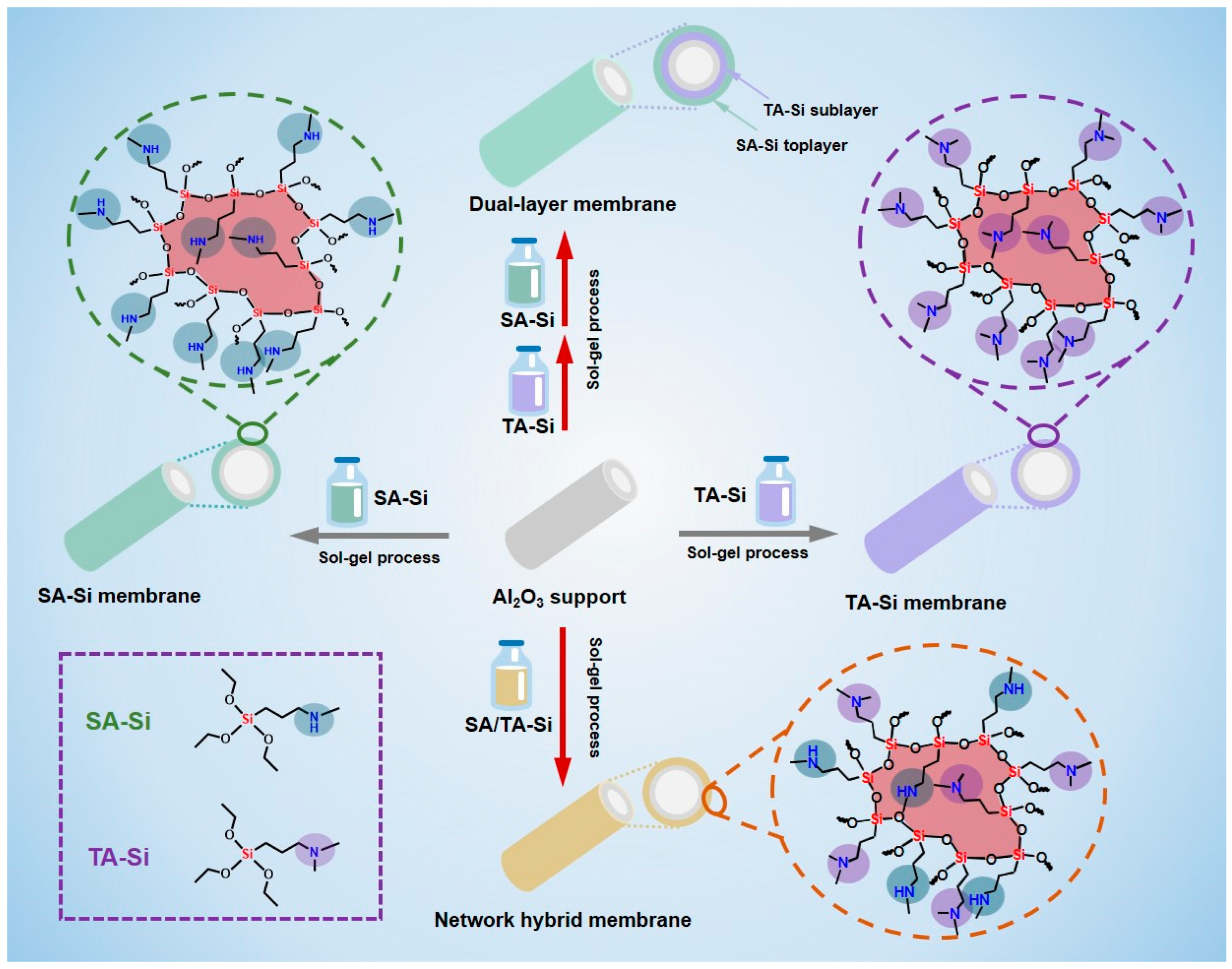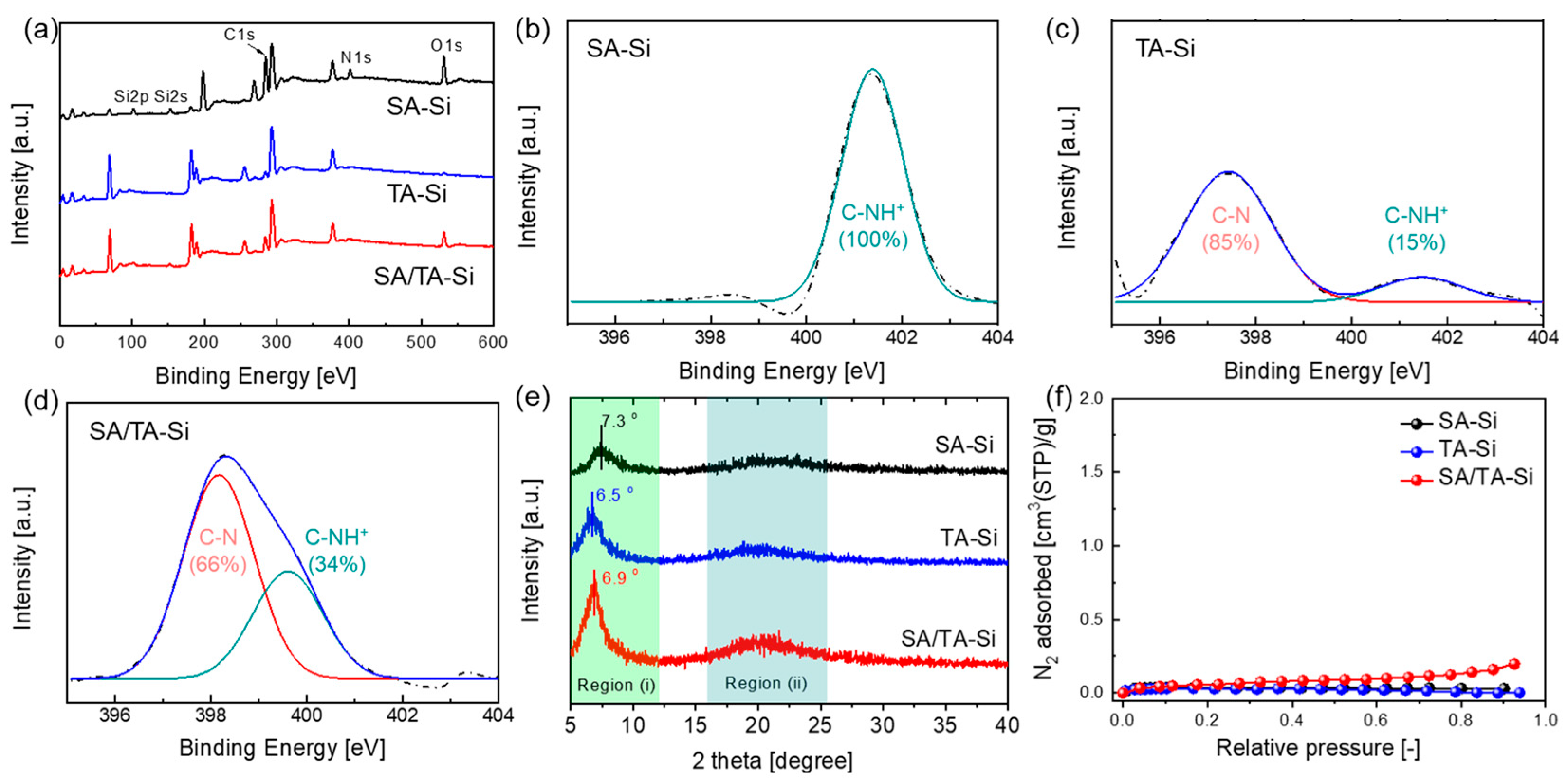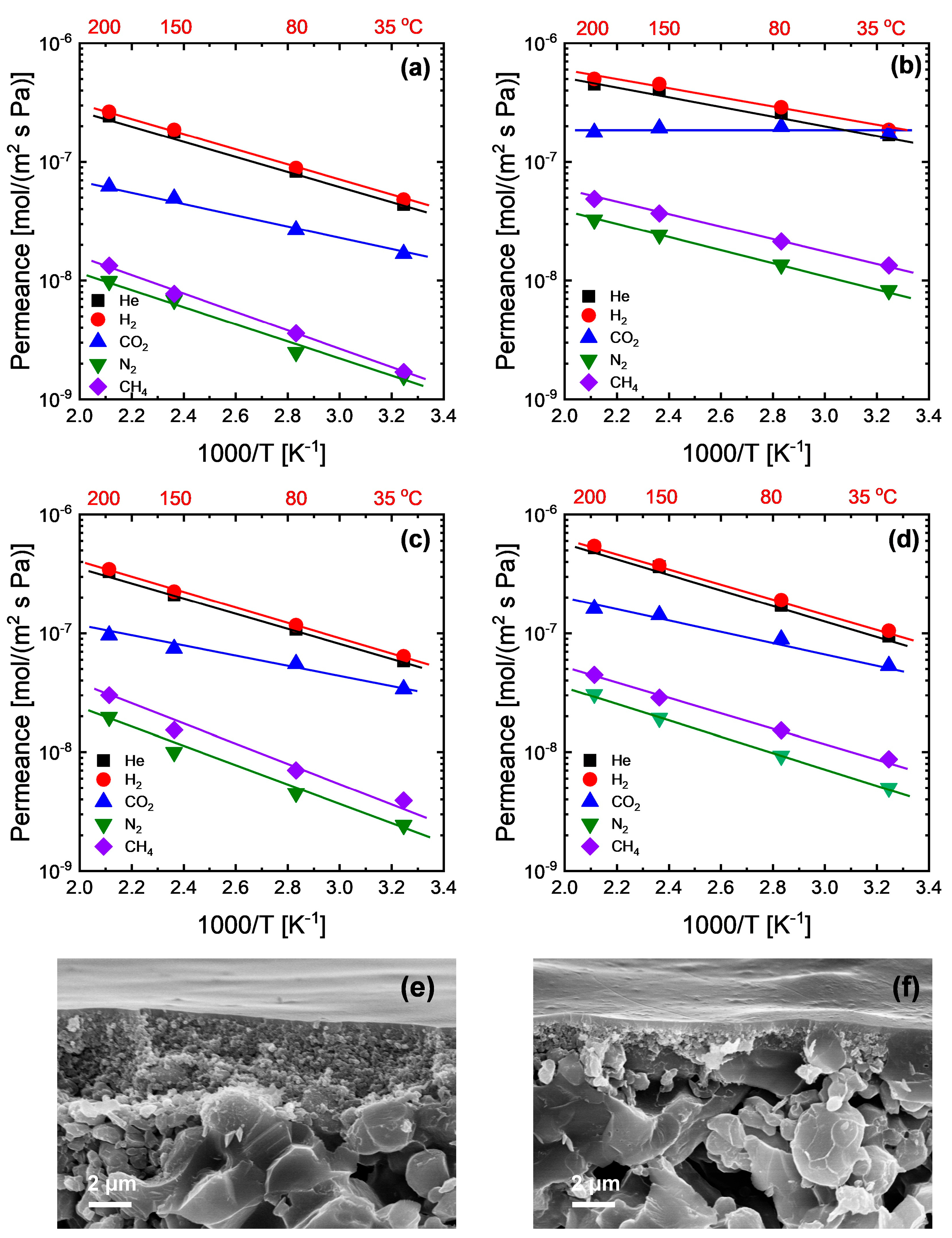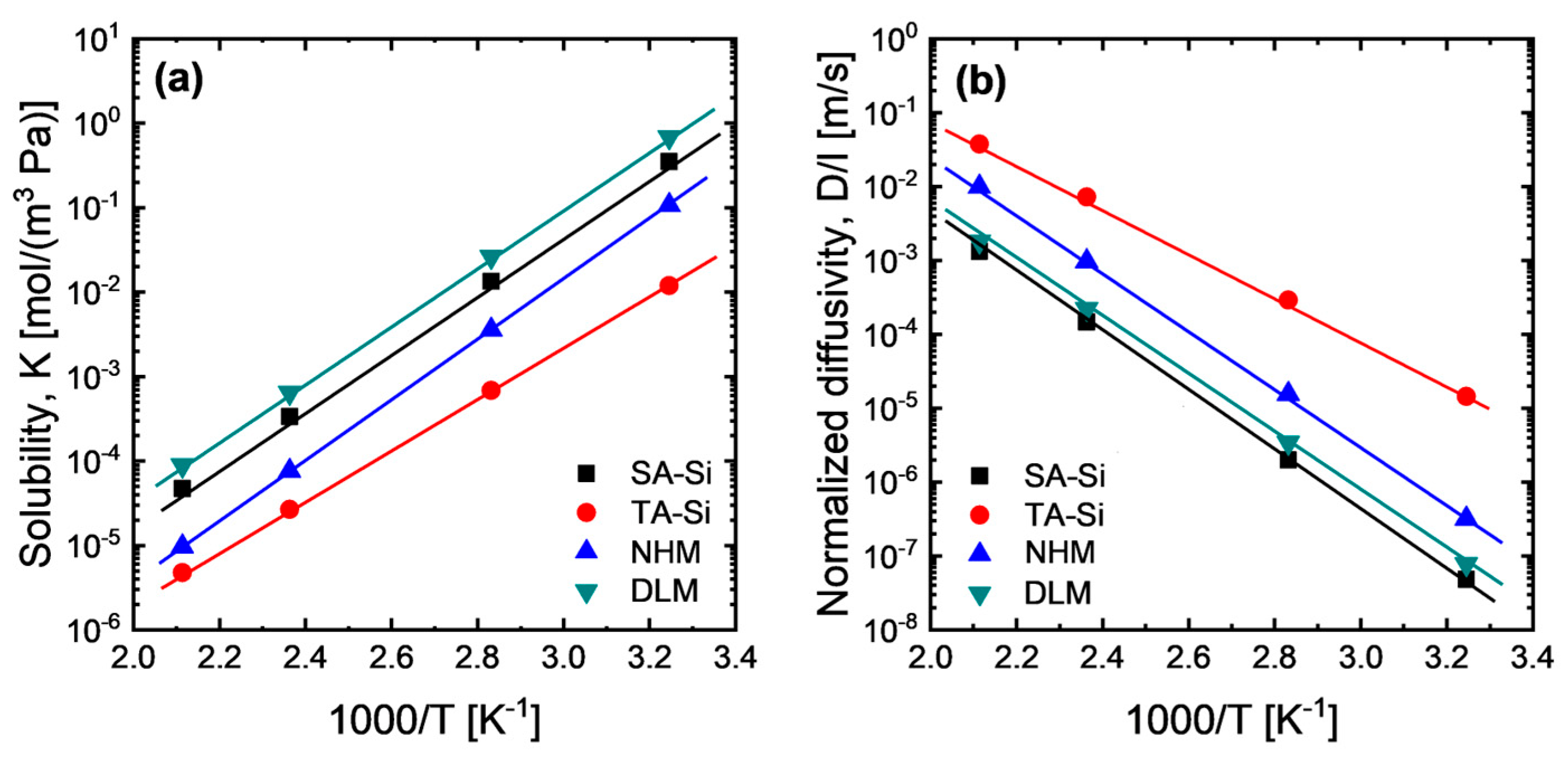3.3. Single-Gas Permeation Properties
To probe the single-gas permeation properties as well as the possible microstructure of the amine–silica membranes prepared from either individual or mixed precursors in this study, gases with different diameters were adopted for single-gas permeation tests, and the results are shown in
Figure 3. All the prepared membranes showed a remarkable molecular size-sieving effect even at relatively high temperatures (e.g., 200 °C), which is almost impossible for most polymeric membranes with a nonporous structure (
Figure 3a,b), suggesting a thermally stable organic–inorganic hybrid structure derived from organosilicon precursors, as confirmed by their physicochemical properties. However, these membranes exhibited a comparable permeance decreasing trend with gas kinetic diameters, even compared with those membranes with porous structure prepared from organosilicon precursors consisting of pendant groups with negligible steric hindrance (e.g., ≡Si-H in TRIES and ≡Si-F in TEFS,
Figure 3c). Unlike TRIES and TEFS, the precursors of SA-Si [≡Si-(CH
2)
3NH(CH
3)] and TA-Si [≡Si-(CH
2)
3N(CH
3)
2] consist of pedant groups with relatively longer chains that would inevitably fill in the voids or pores produced by the rigid Si-O-Si skeleton during their condensation process. Consequently, the steric hindrance and flexibility of the pendant groups play an important role in the textural properties of the hybrid organic–inorganic network. Owing to the similar sizes of the pendant groups of SA-Si and TA-Si, they showed very similar kinetic diameter dependence of gas permeance. However, only a small difference was observed between them, with TA-Si showing a slightly loose structure due to its slightly bulky pendant groups that may accordingly enlarge the rigid network size of the Si-O-Si skeleton. Importantly, these two-novel amine–silica membranes with single-layer (NHM) and dual-layer (DLM) configurations also showed similar trends in the kinetic diameter dependence of gas permeance compared to those membranes prepared from individual precursors (
Figure 3a–d). This phenomenon implies that hybrid and layered hybrid network structures cannot significantly affect the texture properties of these amine–silica membranes. Generally, the activation energy of diffusion for gases through nonporous polymeric membranes scales linearly with the gas diameter squared [
17,
18,
19]:
where
di is the gas diameter, and
m and
y are empirical parameters. Hence, at relatively higher temperatures where the solubility contribution is negligible, a linear relationship between log permeability (or permeance) and gas diameter squared can be observed. Robeson regressed diffusion diameters based on a database of experimental diffusivities and found that the gas diffusion diameters were more representative for the correlation of gas transport properties in polymers (either rubbery or glassy polymers, thermally arranged polymers, polymers of intrinsic microporosity, etc.) than prior zeolite-based kinetic diameters [
20,
21]. Instead, the membranes in this study with a hybrid organic–inorganic network demonstrated a more linear relationship between log permeance and gas kinetic diameter squared for the gases considered (He, H
2, CO
2, N
2, and CH
4) than the case of diffusion diameter squared. This is, nevertheless, also indicative of the strong size-sieving behavior of these membranes. However, together with the Knudsen selectivity for gas pairs of H
2/He and CH
4/N
2, this phenomenon probably suggests that amine–silica membranes possess a different texture property than most popular polymeric membranes due to the rigid Si-O-Si main skeleton that plays a primary role in the diffusion of gases through these membranes. Since the pendant groups attached to the Si-O-Si network have sufficient flexibility or mobility, they cannot provide effective diffusivity selectivity for the permeate gases. The same phenomenon was also observed in the case of highly aromatic polybenzimidazoles membranes with very rigid matrix at a temperature of 190 °C [
18]. In addition, the apparent average pore diameter analysis for the prepared membranes showed an order of NHM (0.44 nm) < SA-Si (0.50 nm) < DLM (0.52 nm) < TA-Si (0.66 nm), suggesting that network hybridization resulted in a denser microstructure, while layer hybridization tended to form an apparent pore size in between SA-Si (top-layer) and TA-Si (sublayer).
Figure 4a–e show the temperature dependence of gas permeance for the membranes with hybrid (NHM) and layered hybrid (DLM) network structures; the relevant activation energies of permeation (
Ep) for the gases considered in this study and CO
2/N
2 selectivity are also tabulated in
Table 1. All the analyzed gases for all the membranes showed a linear relationship between log permeance and inverse temperature that can be well described by an Arrhenius-type equation. NHM and DLM showed very similar activation energies for He and H
2 with membrane SA-Si, indicating similar levels of diffusion barriers. It seems that the hybrid network of NHM and DLM is always dominated by the SA-Si-derived network, which is relatively denser than the TA-Si-derived network. Meanwhile, the CO
2 permeation properties were also largely affected by the SA-Si-derived network consisting of secondary amine groups. However, on the other hand, the gas permeance always followed the order TA-Si > DLM > NHM > SA-Si. It is not so surprising that NHM showed a moderate level of permeance due to the formation of the homogenous hybrid network derived from a relatively dense network and a loose network.
Figure 4e,f show a representative cross-sectional SEM image of the prepared membranes. Both NHM and DLM exhibited uniform, defect-free selective layers with a typical thickness of approximately 100 nm that were well adhered to the porous support. The comparable thicknesses of NHM and DLM, as confirmed by the SEM observation, demonstrate the successful formation of dense selective layers and provide direct visual evidence of their similar membrane morphologies. However, the DLM showed a higher permeance than the NHM at the same level of thickness. Since the permeation mechanism between homogenous single-layer membranes and dual-layer membranes may exhibit some differences due to the possible variations in pressure or concentration distribution across the membrane thickness, predictive permeation models were used for a better understanding of the mechanisms, as described in the next section.
Humidity is expected to play a significant role in the CO2 transport properties of amine-functionalized membranes. In the presence of water vapor, CO2 can react with amine groups to form bicarbonate species, thereby increasing CO2 uptake and facilitating its transport across the membrane. This humidified environment can enhance the overall CO2 separation performance, as has been widely observed for other amine-containing polymeric and hybrid membranes. Moreover, the affinity-gradient structure of our dual-layer membranes is anticipated to be especially beneficial under humid conditions: the high-affinity top layer would promote CO2 sorption, while the underlying low-affinity sublayer would facilitate rapid diffusion and desorption, even in the presence of water. Future work will systematically investigate the effect of water vapor on CO2 permeance and selectivity to fully validate these potential advantages under practical operating conditions.
3.4. Modeling Prediction of Hybrid Membranes
Regarding hybrid membranes, if phase separation occurs, the permeance or permeability can be well estimated based on several predictive permeation models for mixed-matrix membranes (MMMs). The dual-layer membrane is a kind of phase-separated membrane that can likely be estimated based on a series two-layer model (series model) [
22]:
where
Peff is the estimated total permeability;
Pc and
Pd are the permeability of continuous and dispersed phases, respectively; and
Φc and
Φd are the volume fractions of continuous and dispersed phases, respectively. On the other hand, a parallel two-layer model (parallel) could be applied for a parallelly phase-separated membrane, which generally defines the upper limitation of a mixed-matrix membrane:
Therefore, regarding the NHM, if phase separation occurs, the series model and parallel model can define the lower and upper limitations, respectively. In addition, the geometric mean model assumes a random distribution of the phases, and the effective permeability is determined as follows [
23]:
As mentioned above, hybrid membranes (NHM and DLM) showed permeances in between SA-Si and TA-Si at a broad temperature range (
Figure 5). However, NHM membranes showed comparable or even lower permeance compared with the series model’s prediction, indicating the formation of a new hybrid network that was relatively dense. In addition, surprisingly, the DLM membranes showed higher permeance than either the NHM membranes or the series model’s prediction. This is a strange phenomenon for layered membranes, since in some reported cases, the series model or resistance model can describe the gas permeation behaviors well. In this study, we hypothesized that the interfacial effect between the two layers of the DLM can partly affect the gas permeation properties due to variations in the total thickness and the possible voids formed at the interface. On the other hand, generally, the predictive permeation models for mixed-matrix membranes are mainly based on the diffusivity coefficient through each phase (continuous phase and dispersed phase), for which the solubility (or concentration) distribution across each layer is not considered. Hence, for a better understanding of gas permeation behaviors through dual-layer membranes, we sought to establish the permeation equations by considering the chemical potential distribution across the membranes.
Generally, there are two typical transport models presumed to describe the chemical potential distribution in porous and nonporous membranes: the pore-flow model and the solution-diffusion model [
24]. In this study, the amine–silica membranes demonstrated a hybrid network with a nonporous nature, which, however, is different from most popular dense polymeric membranes, as mentioned above. Therefore, we hypothesized that the chemical potential distribution across the dual-layer membranes follows the solution-diffusion model or a hybrid model consisting of both solution-diffusion and pore-flow models, as illustrated in
Figure 6.
where
dµi/
dx is the gradient in chemical potential of component i, and
Li is the proportionality coefficient associated with the chemical potential. Regarding compressible gases, the chemical potential can be written as follows:
Since diffusion across the membrane is always significantly more difficult than adsorption–desorption at the membrane interface of both the feed and permeate sides due to the relatively dense membrane matrix or narrow pore size for gas separation membranes, we hypothesized that adsorption of the penetrated gas at the interface is always in an equilibrium state. The discussion below covers two cases: a solution-diffusion model and a hybrid model.
In this scenario, we assume the following conditions: (i) constant pressure across each layer and pressure drop occurs at the interface of the permeate side; (2) concentration decreases gradually across each layer; (3) the diffusion coefficients across each layer are comparable.
Then,
where
γi = 1 for simplification. This equation has the same form as Fick’s first law when we replace
LiRT/
ci with the concentration-dependent diffusion coefficient,
Di.
Regarding single-layer membranes, at the interfaces for a specific gas species i, the following expressions should hold:
Feed side: c1 = Kip1; permeate side: c2 = Kip2
After integrating over the membrane thickness from 0 to
l,
where
DiKi/
l is the gas permeance (thickness normalized permeability), and
Di/
l is the thickness normalized diffusivity coefficient.
Similarly, regarding dual-layer membranes, at the interfaces for a specific gas species i, the following expressions should hold:
Feed side: c1 = Ki1p1; permeate side: c2 = Ki2p2
After integrating over the membrane thickness from 0 to
l,
To obtain a similar expression with the single-layer membrane, the above equation can be changed as follows:
where
is considered the averaged solubility coefficient across the dual-layer membrane (
KDLM). If
Ki1 =
Ki2, the transport equations for dual-layer membranes can be reduced for single-layer membranes. If
Ki1 >
Ki2, it is easily deduced that
>
Ki1 >
Ki2. Conversely, however, if
Ki1 <
Ki2, we obtain
<
Ki1 <
Ki2. This suggests that the configurations of dual-layer membranes tend to adjust the solubility gradient across the membrane.
In this scenario, we assume the following conditions: (i) both concentration and pressure in the membrane decrease gradually across the membrane thickness; (ii) the diffusion coefficients across each layer are comparable.
Similarly, we replace
LiRT/
ci by
Di and replace
LiRT/
pi with Darcy’s law coefficient,
ki.
In the case of a single-layer membrane, after integrating over the membrane thickness from 0 to
l,
where membrane permeance (
P) is the sum of the contributions from Fick’s law (
DiKi/
l) and Darcy’s law (
ki/
l).
Similarly, in the case of a dual-layer membrane, after integrating over the membrane thickness from 0 to
l,
As indicated previously, in the solution-diffusion model, if Ki1 > Ki2, we obtain KDLM > Ki1 > Ki2. Therefore, the configurations of the solubility gradient may play an important role in gas permeation properties for dual-layer or multi-layer membranes. It is worth noting that the dual-layer or multi-layer membrane in this study comprised a membrane with a layered structure and comparable diffusivities across each layer. The conclusions in this study may not be correct for asymmetric membranes with very different texture properties in each layer.
To verify the possible effect of the solubility gradient across each layer, we investigated CO
2 solubility at a broad temperature range of the amine–silica membrane with a homogenous matrix (SA-Si, TA-Si, and NHM) and the average solubility of the DLM, as shown in
Figure 7a. Apparently, the NHM showed CO
2 solubility in between SA-Si and TA-Si due to the mixing effect. It is easier to speculate that the high-solubility material (SA-Si) defines the upper bound of the solubility of the hybrid material, while the low-solubility material (TA-Si) defines the lower bound. However, as calculated, the solubility of the dual-layer membrane can exceed the upper bound of the high-solubility material (SA-Si). This implies that the solubility gradient can be further adjusted based on the configurations of dual-layer or multi-layer membranes with different levels of solubility to the penetrated gas compared with these homogeneous membranes. Moreover, the high-solubility material should be configured as the topmost layer, while a moderate-solubility material should be a sublayer or transition layer to further enhance the solubility gradient. Indeed, generally, there is concentration (molar/volume) enrichment of the penetrated gas in both feed and permeate sides, particularly for high-condensable gases (e.g., CO
2), based on a Boltzmann distribution:
Here, ca and cb are the adsorbed concentration and bulk (gas phase) concentration, respectively.
The concentration enrichment in the feed interface is mostly a positive effect for gas permeation, while the concentration enrichment in the permeate interface exerts a negative effect that may reduce the effective concentration gradient.
Figure 7b summarizes the thickness-normalized diffusivity of the amine–silica membranes obtained after the disintegration of membrane permeance based on
P = K*D/l. There are order differences in diffusivity between SA-Si and TA-Si membranes, which suggests that the DLM is not an ideal dual-layer membrane that can be well described by the dual-layer transport equations shown above. However, there is still room to discuss the contributions of solubility and diffusivity to the membrane permeance (or permeability), since the diffusivity coefficient is always an inconstant parameter linked with the relevant driving forces for flux. By comparing the normalized diffusivity among amine–silica membranes, one may find that the DLM with higher permeance than SA-Si and NHM showed even lower or comparable diffusivity, suggesting that the enlarged solubility gradient of DLM based on the configurations of dual-layer structure plays a more important role in CO
2 permeation properties. It should be noted that, in this study, direct layer-specific sorption measurements on the actual dual-layer membranes were not conducted. Instead, gas adsorption isotherms of the corresponding xerogel powders (SA-Si and TA-Si) were employed to estimate the relative CO
2 affinities of each component. While informative, these adsorption measurements on xerogels cannot resolve the spatial distribution of solubility within the layered membrane structure and thus cannot directly confirm the existence of a solubility gradient.















